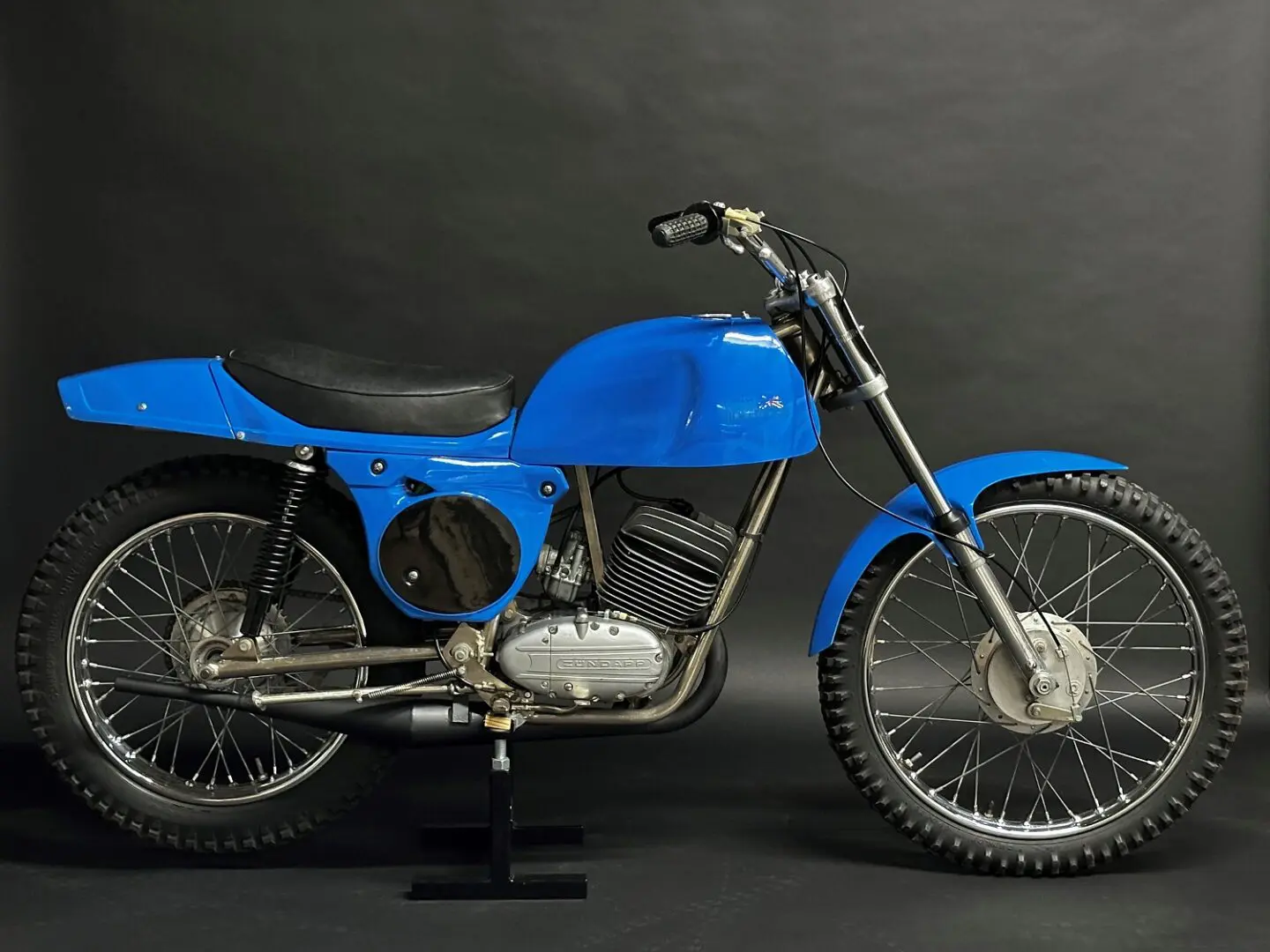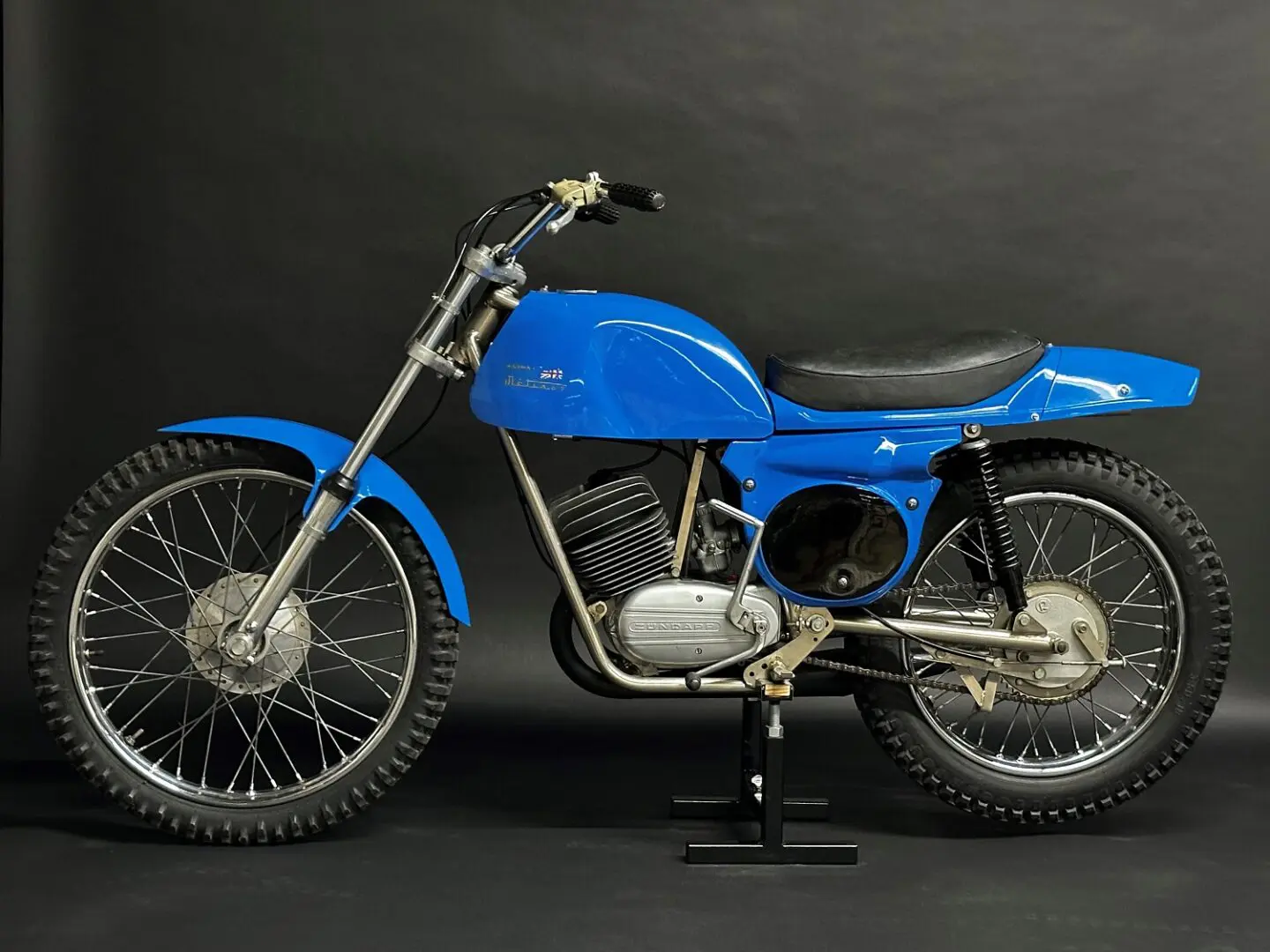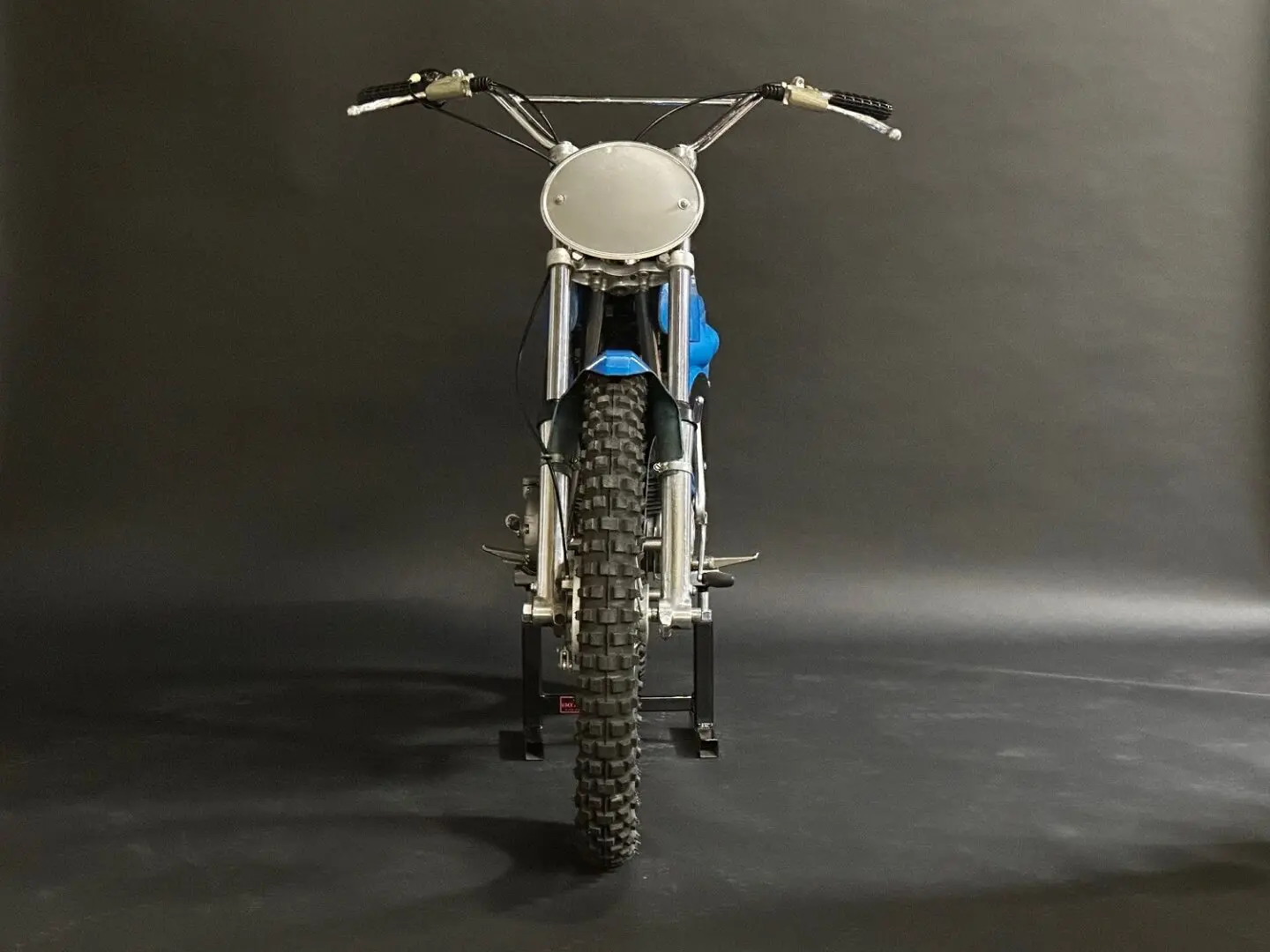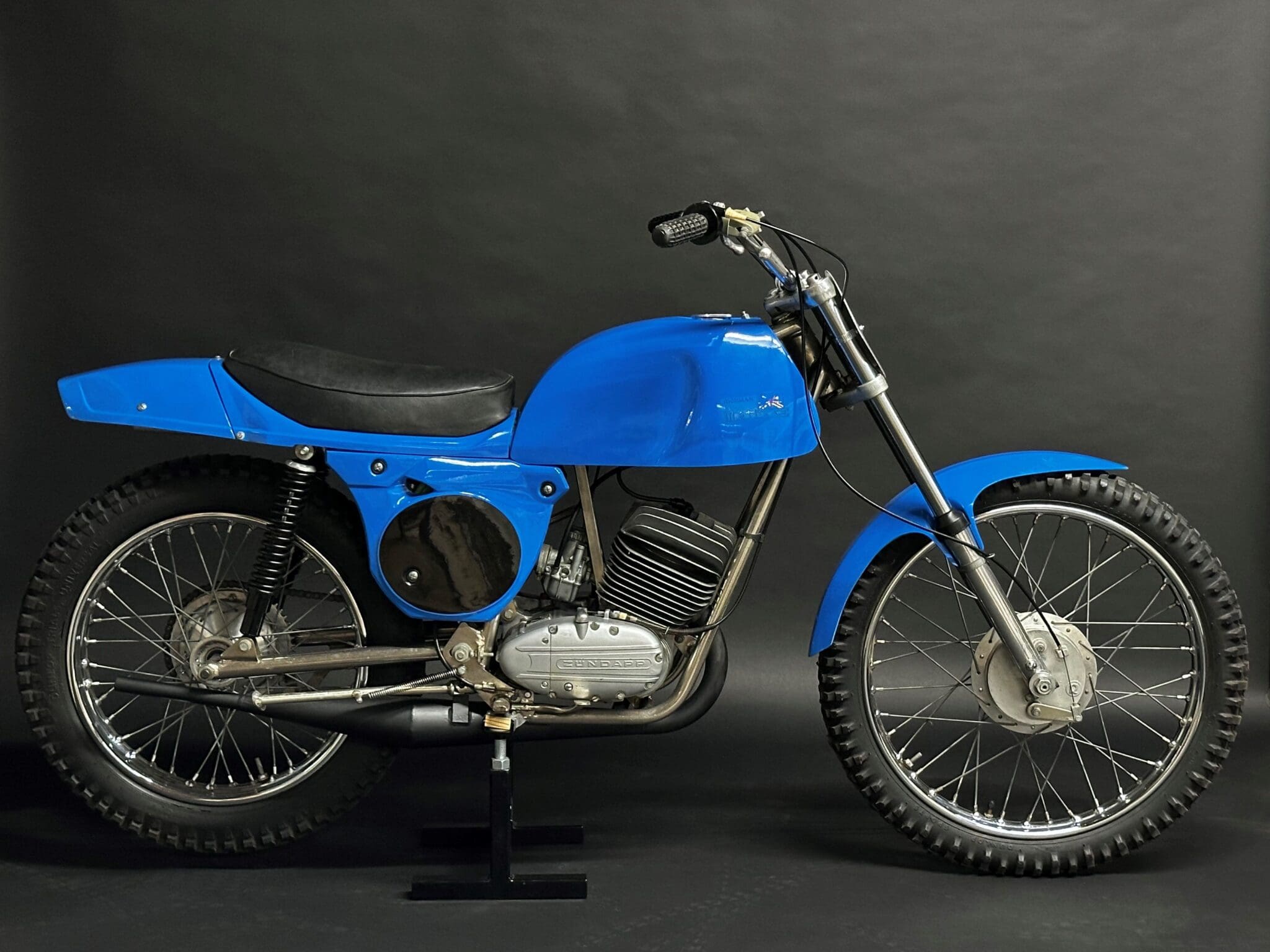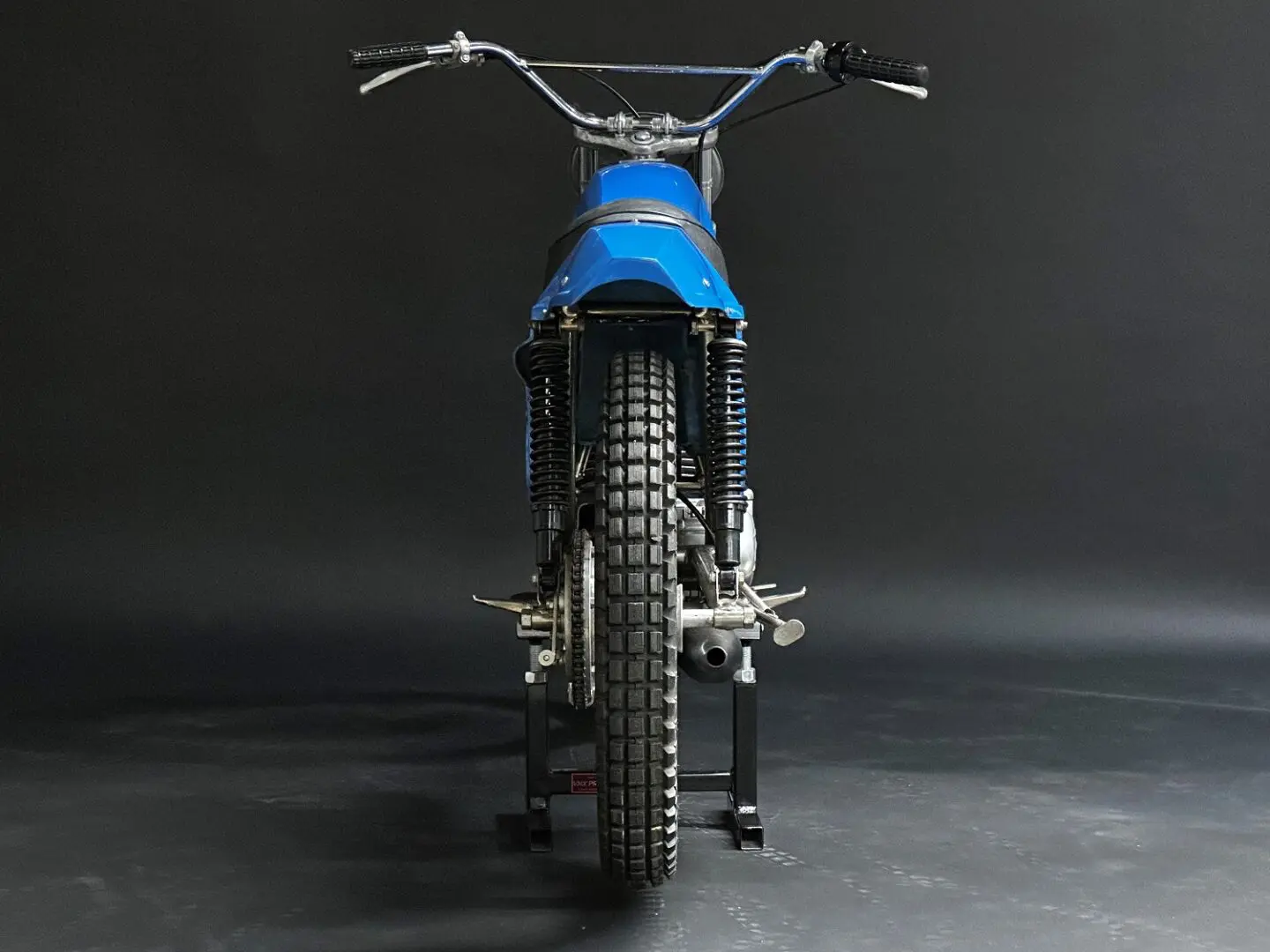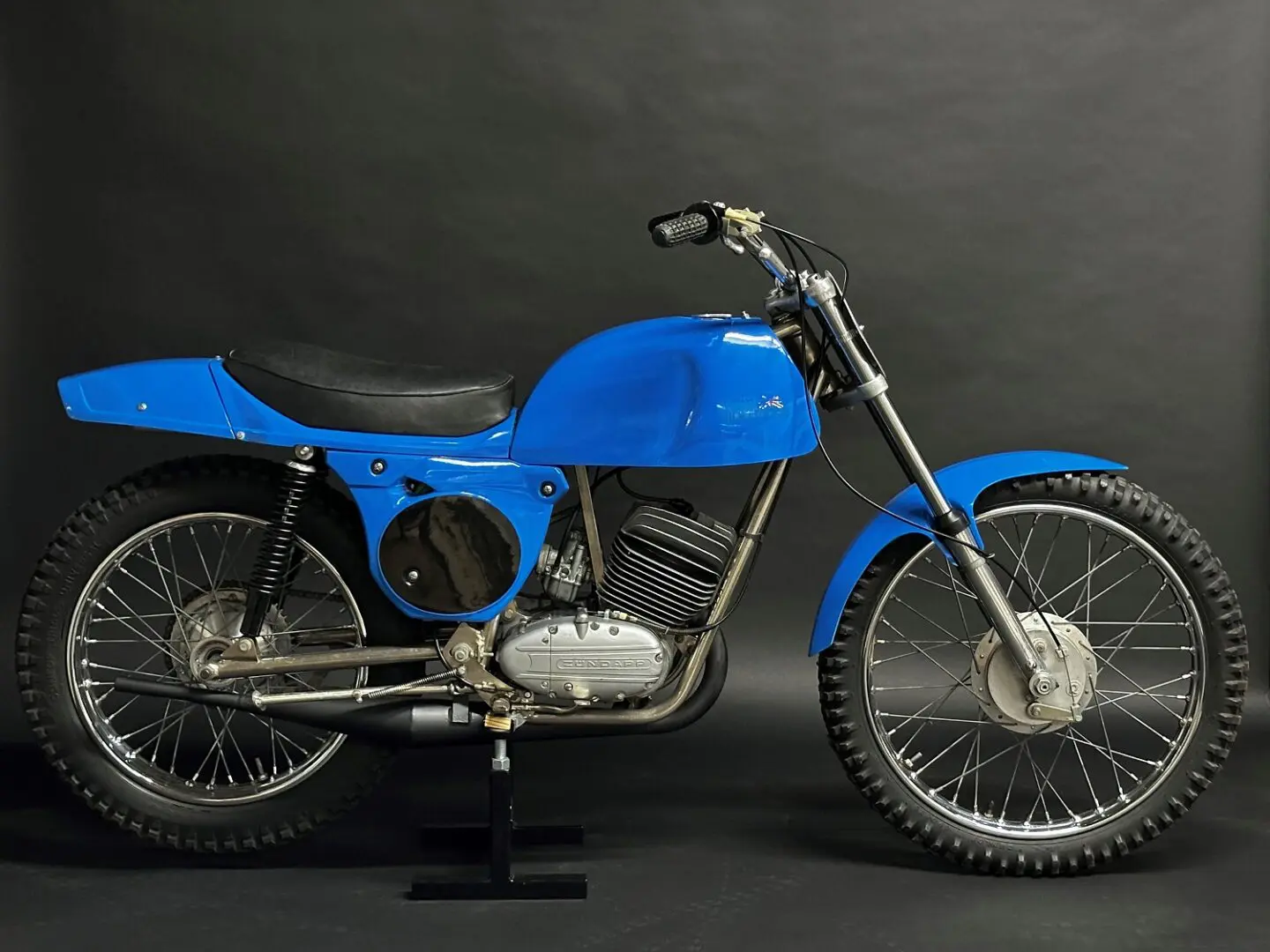1971 Rickman Zundapp 125MX
Model Information
Company History:
Around 1950, British Grand Prix racers Derek and Don Rickman began racing scrambles when they were sixteen years old, the age at which you could apply for an Auto-Cycle Union competition license. At that time, purpose-built scrambles bikes didn’t exist, and racers were riding converted road bikes by brands such as BSA, Norton, AJS and Matchless. The heavy-duty components on these bikes were designed to last, not for competition.
To make their bikes more competitive, racers began building “specials” combining the best components from various brands such as the BSA frame and motor, Norton forks, Matchless front wheel and Ariel rear wheel. While the Rickman brothers were beginning to have success on Grand Prix circuit, in the background and in great secrecy, they were developing their own special. Debuting in 1959 with a BSA frame and a Triumph twin 4-stoke motor, they dubbed it the Matisse or mongrel since the result was a cross of different bike brands. That year it was reported that Derek won every race he entered on the new Matisse.
Shortly thereafter, they realized they would need to improve the BSA frame and swingarm. They set out using high quality, lightweight Reynolds 531 tubing. A new chain adjustment system was also designed with the adjustment being made at the front of the swingarm rather than the rear axle. The frames were bronze welded by hand and once completed they were nickel plated. The result was a frame that dramatically improved handling and was 22.5 pounds lighter than the BSA frame. They also designed a custom fiberglass tank, seat section, air cleaner cover and fenders. Fiberglass was relatively new and unknown to motocross at the time.
Between the brother success on the Grand Prix circuit and the beautiful bikes they were riding, they began to get requests from other racers for Metisse replicas. At that point, sensing new competition BSA and Triumph refused to supply engines to Rickman. Shortly thereafter, in 1965 Bultaco, Husqvarna and Montesa would join Jawa and CZ with 360cc 2-stroke scrambles bikes capable of competing with the best 500cc 4-strokes.
Although Rickman frames were originally sold in the US market through PABATCO (who later developed the Hodaka brand), distribution was ultimately appointed to John Steen and Lyn Wineland. In 1971, Rickman decided to build their first complete production motorcycles – three models and all 2-strokes. In consultation with Steen, they decided to build an Enduro and MX 125 model utilizing the German Zundapp engine and a 250 MX model with a Spanish Montesa engine.
After the distribution effort of Steen and later BSA Inc of America faltered, Rickman Inc was established in 1974 to run all US operations. With the advent of the lighter, faster, cheaper Japanese brands, Rickman withdrew from the US market in 1975. By 1976 production of the Rickman Zundapp and Montesa had virtually ceased and the business was ultimately sold in the 1980’s.
The Bike:
The Micro-Metisse as the two-stroke Rickman’s were known were an attempt to capitalize on the American demand for race-ready machinery. The Rickman frame could be acquired alone and would accommodate a 100cc Hodaka engine, a 125 or 175cc Yamaha engine or the Zundapp engine. The first year of the Rickman 125MX complete racer was 1971. It came with the potent 125 Zundapp engine and cost $895, the cost of many 250’s at the time. For comparison, the 1971 Zundapp 125MX cost $750. As Cycle World said “for the extra money you are getting everything there is to be had in definitive dirt rising hardware, not to mention that characteristically bullet-proof, long wheelbase Rickman design, which seems so peculiarly suited to American riding conditions.” With a wheelbase of 53”, it was about 2-3” longer than a typical 125.
In 1971, the Rickman frame, Zundapp motor, Bing carb, Ceriani suspension front & rear and Magura levers were a winning combination for American motocross. The rubber dust covers over the clutch and front brake pivot points were cutting edge. Interestingly, the 1971 Rickman Zundapp 125MX was tested in the first ever issue of Dirt Bike Magazine, June 1971. Although designed for MX, the magazine tests stated that the Zundapp motor had enough low end to putt around the countryside in low gears.
One of the most noticeable features of the Rickman 125 is the small vinyl covered seat. Although attractive, it was not practical. Handling was Rickman’s strong suit and the 125MX shined. As Dirt Bike Magazine put it “If really does improve your riding by 25%.” However, the magazine also stated that “the Zundapp gearbox had a bad case of the neutrals.” The Ceriani front forks offered 6” of travel which was significant at the time. The 3” of travel in the rear was more typical. The cast magnesium conical hubs kept the unsprung weight to a minimum. All fiberglass was extremely attractive, tough and free from blemishes, but the first crash would often significantly scratch the beautiful paintwork.
The 1971 and 1972 models came in US Racing Blue. The primary difference between the 1971 and 1972 models was the ’72 had a different Zundapp engine, an up-pipe and a raised front fender. The 1971 was the only year with the low front fender. In ’73 the color changed to Rickman Red. Although the ’71 model came with a downpipe as stock, an up-pipe was available as an option and the left side panel was pre-designed to accommodate it. Other options included a larger gas tank, front number plate and kickstand. 701 125MX bikes were manufactured in 1971.
Dunlop tires came standard on the bike. I’m not certain why Rickman utilized a trials tire on the rear, but I’ve either read or heard somewhere that the Zundapp LI series motor had a fragile transmission when under extreme load. A trials tire would let the rear end break loose rather than damage the transmission. Black plastic number plates were molded into the fiberglass side panels and although a paper air filter element was stock, Steens replaced it with a foam type filter prior to delivery.
As Cycle World concluded, “The Zundapp Metisse combination is meant for racing, very serious racing.”
1971 Rickman Zundapp 125MX
This is a 1971 NOS/NEW Rickman Zundapp 125MX. It is amazing that the fragile fiberglass and beautiful paint work on this bike has remained flawless after 50 years, a testament to the quality of craftsmanship that Rickman was known for. In fact, the fading tank decals are the only thing to show any signs of aging. With the exception of the front number plate, everything on this bike is original. I’ve been lucky enough to collect a few NOS bikes for the collection and they usually have a scratch or two from sitting in a garage or warehouse or from transferring from one owner to another. The fact that this bike doesn’t have a single flaw is remarkable.
In April 2023, I acquired this bike from Kaplan Cycles, a vintage mx restoration house and motorcycle dealer in Vernon, CT. It is also the location of the New England Motorcycle Museum. This bike was shipped from Rickman in England to a dealership called Vernon Cycle & Sport in Tolland, CT where the original owner purchased it. Frank DeGray, the owner of Vernon Cycle & Sport uncrated the bike, assembled it, started it, signed the Certificate of Origin and sold it to the owner. Frank also gave the buyer a slat from the wooden crate that the bike was shipped in. That wooden crate slat with the “Rickman Made in England” marking and the original Parts Manual remain with the bike to this day.
My understanding is that the original owner never rode the bike and instead decided to keep it new then sell it for a substantial gain someday. That day came in February of 2023 when a friend of Bob Holmes told him this bike was for sale. Bob is a lifelong motorcycle enthusiast, who at 76 years old still rides today. He purchased the Rickman with the intention of riding it in the woods behind his house – until he was informed by the original owner that the bike hasn’t been started since Frank DeGray started it for the first time during assembly at the dealership fifty-one years ago. Bob even took off the head to confirm the bike was never ridden. Thankfully, Bob realized he was in possession of a piece of motocross history and that the bike likely belonged in a museum or collection. He then contacted Kaplan Cycles and the New England Motorcycle Museum who purchased it from him. Franks son Peter provided an original image that he had in his archives of a ’71 Rickman Zundapp being uncrated at Vernon Cycle & Sport. It may very well be this bike.
Frank DeGray wasn’t just a motorcycle dealer; he was an accomplished trials and enduro rider winning the New England Enduro Grand Championship in 1960 and 1962. Frank established Vernon Cycle & Sport in 1964 and during his 45 years in the business, he also carried the Triumph, BMW and MZ motorcycle brands. He was also an avid collector and restorer of motorcycles and was known to have invented the first route sheet holder for enduro racing.
My contact at Kaplan Cycles was Billy Blythe a lifelong motorcycle competitor. What really brought this acquisition full circle was Billy’s connection with Frank DeGray. In the mid ‘60’s, Billy’s father would bring him to Frank’s dealership to see all the motorcycles. When Billy got older, he actually got to ride with Frank and his ISDT friends, learning early on how skilled and fast these guys really were. Billy went on to become an accomplished racer in his own right as a 4-time Isle of Man competitor and an expert level trials rider getting a factory Ossa sponsorship at 16 years old.
Although I collect these motorcycles in part to preserve the history of early 125 motocross bikes, as is the case here, the provenance can often add significant color and insight into such an exciting time in American motocross history.
